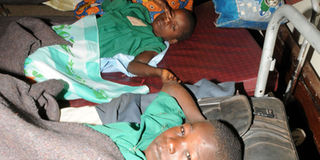Lightning death toll rises to 21

RECOVERING: Pupils of Runyanya Primary School at Mulago Hospital where they were admitted after lightning struck their school on Tuesday. PHOTO BY STEPHEN WANDERA
Kampala/Kiryandongo
The death toll following Tuesday’s sporadic bolts of lightning, which struck three different locations around the country, has climbed from 18 to 21, with the government admitting that there was little it could do to prevent the devastation.
This brings the total number of people who have died in the past one week to 31. A meteorology expert from the Environment Ministry, Mr Michael Nkalubo, yesterday told reporters at a media briefing in Kampala that the new wave of lightning strikes are the result of “an unusual” surge of moist air flow from the Atlantic Ocean, through the Congo Basin combined with dry spells leading to outbreaks of showers and thunderstorms. “Lightning by its nature and evolution is a very unpredictable event,” he said. “It can strike in the most unexpected places and do the most unexpected damage.”
No conductors
At the same briefing, Mr Musa Ecweru, the Disaster Preparedness state minister, admitted that the lack of lightning conductors, a metal device mounted on buildings to prevent strikes of lightning, was part of the immediate cause of death in many of the districts it struck.
“Unfortunately there were no lightning arrestors in all the areas and other places where lightning has struck,” he said. Mr Ecweru also admitted that there had been a laxity on the part of government in ensuring that all buildings are constructed with conductors but said the Ministry of Works would “issue a circular to enforce these construction codes”.
“Over the years there has been a reluctance to enforce these building codes. It is until now that we have realised that many schools and health centres do not have these conductors,” he said, adding: “Yes, there has been negligence on the part of those who certify if building are fit for public use.”
Mr Nkalubo said unseasonal heavy rainstorms in the past two weeks had brought with it the devastating effects of lightning bolts.
In Kiryandongo District, where the biggest destruction has since been recorded, bodies of at least 19 victims of Runyanya Primary School had been handed to relatives and parents by yesterday evening, as burial arrangements got underway.
Second time
This is the second time in recent years that lightning has struck the school, which was opened in 1971. Tuesday’s attack left 19 pupils dead, 12 of whom died on the spot with the rest passing on at Kiryandongo Hospital.
Mr Joseph Obua, the LC 1 Chairman of Mahonge, a village near the school, told Daily Monitor yesterday that lightning struck the school in 2001 and injured three people, including a nurse who had gone to carry out an immunisation exercise.
Ms Betty Busingye, a resident of Nyabiiso, another village that borders the school, told this newspaper that four years ago, a very strong wind blew off one of the roofs of a classroom block.
The building has remained without a roof since then.
Yesterday, the government moved to the aid of bereaved families, making partial contributions of food and money to aid burial arrangements. On their part, district officials agreed to make a contribution of Shs100,000 to each of the families of those who lost dear ones.
Tuesday’s destruction was also felt in the districts of Kotido and Sironko, where two people died instantly. Raffle Lotyang, a primary three pupil at Kotido Army Primary School was killed at around 4:30pm as he walked to his home in Lobua Village Rengen Sub County.
Around 3pm the same day, lightning struck dead 58-year-old Hassan Wandulu in Sironko District but left his sister, Hamida Kakai unconscious. “We were seated outside when it started raining heavily, so we immediately went inside the house. My brother sat close to the door-way and I sat exactly next to him. Shortly the rains increased, there was lightning that forced itself through the door way inside, it sent my brother on the ground in one corner and I was also sent in another corner,” she told Daily Monitor in an interview yesterday.
Measures to avoid lightning bolts
* All buildings and electrical objects must have lightning conductors.
* There should be strict adherence to construction guidelines regarding installing of lightning conductors on buildings and electrical installations.
* Standing under a tree during thunderstorm is very dangerous because lightening strikes the tallest object around any open ground.
* If you are caught in the open during a thunderstorm, lie down and touch as little surface on the ground as you can.
* You are fairly safe in a car as the metal body of the car is a better conductor of electricity but avoid touching the metal of the car.
* Standing on open places like sports grounds, beaches, and open gardens is more dangerous than being in a car park.
* Telephones, electrical appliances and the water taps, showers, wash basins and sinks, are some of the things to avoid when thunderstorms are raging because they all have copper which is an excellent conductor for electricity.
* Avoid showering when it is thundering.
* If you are in a group, each person must stand at least 50 feet apart in order to minimise group injuries.
* Seat on the heels of your feet with toes touching the ground so as to lower your height.
* Tuck your head between your knees. Doing this will minimise any chance of a strike on your head so your chances of survival are better.
* Keep your ears covered to protect against hearing damage and close your eyes to minimise blindness due to close strikes.
* Remove jewelry, watches and other metals as these might cause severe burns if you are struck.
* Stand on plastic sheet, sleeping pads, rubber soles or sandals or such other things which will help isolate you from wet ground.
* Hold your position until the storm passes.
Additional Reporting by David Mafabi, Steven Ariong and Hudson Apunyo




